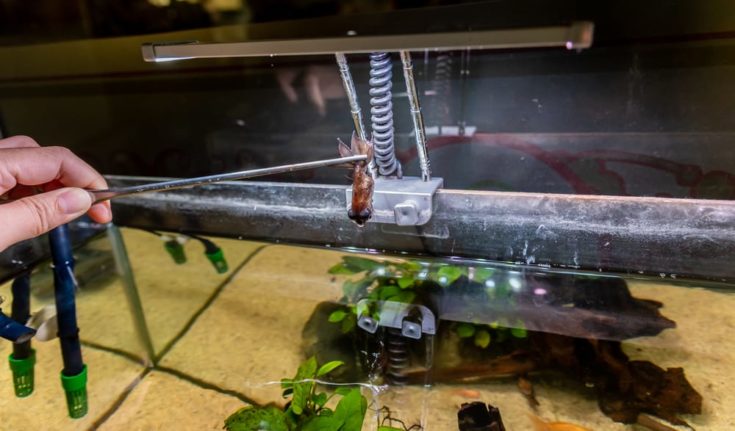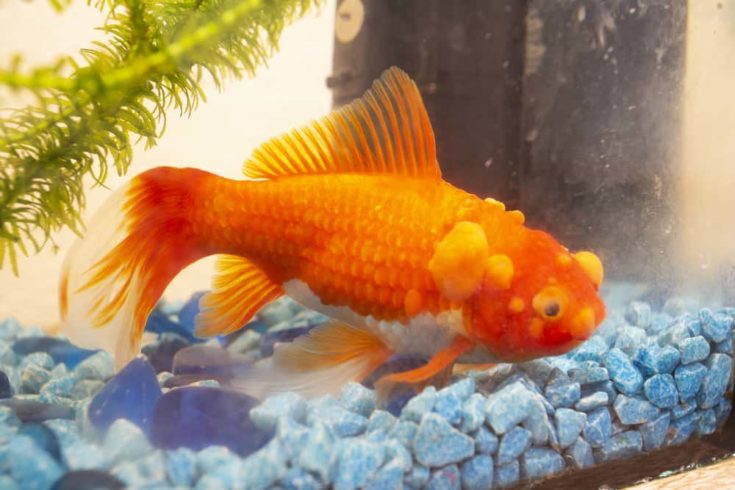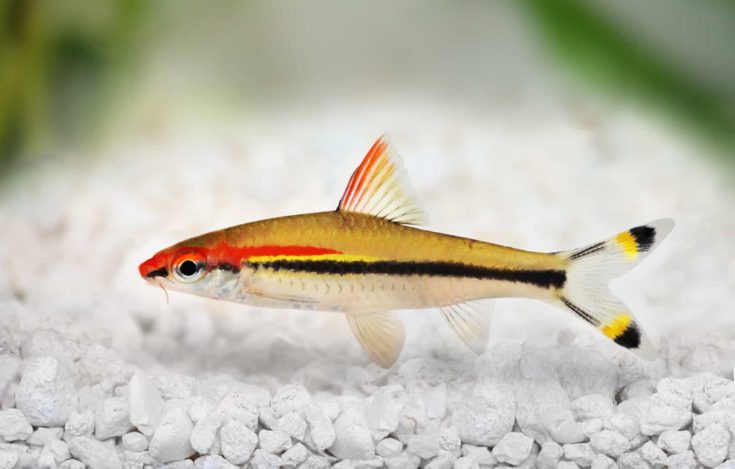When a fish is so sick that it can’t be saved, what do you do?
Generally, you find your fish already floating belly-up in your fish tank, having expired during the night. But if your pet has been sick for a while and nothing you try seems to work, you need to help the poor thing on its way. But do you know how to euthanize a fish?
Read this guide to find out how to humanely euthanize your fish.
When And Why Do You Need To Kill A Pet Fish?

Even the most well-cared-for fish can succumb to parasites and diseases, especially as the fish enters its senior years and becomes more vulnerable to sickness. And sometimes, if nature doesn’t intervene, you will need to make the final decision for your beloved pet.
For example, recently, my 15-year-old fancy goldfish developed a serious bacterial infection. I treated him, and he began to recover, but then the infection spread to his swim bladder and left him completely unable to swim at all. The poor fish just lay on his side on the bottom of the tank, unable to move or feed. None of his tank mates were sick at all, so I concluded that poor Walt’s time had come, and I decided to euthanize him.
Euthanization
Euthanization or euthanasia is commonly known as “putting to sleep.” And essentially, that’s what you’re doing. Rather than leaving a fish, or any other pet for that matter, to suffer for days or even weeks, it’s much better to humanely and painlessly put your beloved old friend to sleep. Basically, euthanization is mercy killing.
In the case of cats, dogs, rabbits, etc., you would take your pet to the veterinary clinic. The vet determines whether there’s any chance of treating the animal and offers the owner advice as to the kindest, most humane course of action. If it’s decided that the best thing for the pet is for it to be put to sleep, the vet will euthanize the animal under controlled conditions.
However, not many people take a fish to the vets to have it euthanized. For one thing, transporting the fish to the vet is likely to be extremely stressful for the fish, and, secondly, vet’s bills are expensive. So, most hobbyists do the deed themselves.
Factors To Consider Before You Decide To Euthanize Your Fish
So how do you know when it’s time for your fish friend to go to that great fish pond in the sky?
Is It Time To Euthanize Your Fish?
Deciding whether it’s time to send your fish on his way is difficult.
If the fish is sick, you need to try to determine what’s wrong, as you might be able to cure the illness and save your fish relatively easily.
Also, beginners often make the rookie error of not cycling the tank properly before adding fish, neglecting weekly water changes and filter maintenance, or not using a water conditioner to neutralize the chlorine and chloramine in tap water when topping the tank. Neglecting all or any of those basic elements of fishkeeping can lead to fish sickness that’s easily fixed by cleaning the tank properly and refreshing the water.
However, if you’ve tried everything and the fish is no better or gets worse, it’s probably time to admit defeat and euthanize the creature.
What is Pineconing?
Pineconing isn’t a disease in itself but is a symptom of several different diseases, most of which are extremely serious for your fish.
The term pineconing is used when the fish’s body becomes so swollen and distended that its scales stick out from the body, giving the creature the appearance of a pinecone. The condition is caused when diseases such as dropsy cause fluid to accumulate within the fish’s abdominal cavity, making it swell up.
Generally, it’s impossible to figure out the underlying problem. Usually, if the fish has reached the pineconing stage, the disease is too far gone to treat successfully and is probably already dying.
Have You Done Enough To Treat The Fish?

When a fish is sick, you need to carry out extensive research to determine the cause of the problem and treat it. When you’ve diagnosed the likely cause of the fish’s problem, ask your local fish store or vet clinic for recommendations on how to treat the condition.
Be patient when treating your fish, as you need to give the fish’s immune system a chance to react to the disease and fight it off. Follow the instructions on any medication you’re using to treat the condition and carry out water changes to ensure that your aquarium water is clean and healthy for your fish.
Has The Fish Lost The Will To Fight
Instinct causes all living creatures to fight to survive. A healthy fish will be active, swimming around the tank, feeding, and generally behaving as you’d expect the species of fish to behave. Sick fish that have lost the will to fight will show some of the following behaviors:
- Resting on the substrate
- Hanging at the water surface
- Unable to swim on an even keel or at all
- Clamped fins
- Not feeding
- Labored or extremely rapid breathing
Schooling species of fish will often not swim with their tank mates. A shoaling fish that’s hanging around on its own, hiding among your plants, is often a very sick fish that’s close to death.
Quick and Humane Way to Kill Your Beloved Pet
When discussing the best way of helping your fish to pass away peacefully, I stress the word “humanely.” Later in this guide, we’ll take a look at a few undesirable and cruel ways of killing a fish. But now, I want to talk about gentle, painless methods of euthanizing a fish.
Death By Overdose With Anesthetics
Many of the following methods of dispatching your fish are generally used by veterinarians. However, there are some that you can use safely and easily at home.
Tricaine Methanesulfonate (TMS)
This method of humanely euthanizing fish is often used by universities and vets. TMS or MS222 is commercially sold as Finquel. You can obtain this product from good pet stores and online.
TMS is the only product that’s FDA approved for anesthetizing and euthanizing fish. Follow the manufacturer’s directions carefully to get the best dosage rate and fastest way of dispatching your fish. I used a similar product to euthanize my poor fancy goldfish. The whole process took less than 20 minutes and worked extremely efficiently.
Benzocaine Hydrochloride
Benzocaine hydrochloride is a veterinary medicine that you can only get on prescription from your vet clinic.
Note that only Benzocaine hydrochloride is advocated by the AVMA, not straight Benzocaine. Benzocaine isn’t water-soluble, so you need to combine it with ethanol or acetone, both of which irritate fish tissue.
Clove Oil/Vodka Method
The internet is full of articles advocating the use of clove oil or vodka for anesthetizing fish. But the method also entails using an alternative means of killing the fish once it is anesthetized, as overdosing the fish with clove oil won’t kill it.
The AVMA doesn’t condone the use of clove oil for fish euthanasia or killing a fish with vodka or rubbing alcohol because of a lack of research.
Death By Injection – Barbiturates
It is possible to euthanize a fish by injecting an overdose of barbiturates into its bloodstream. Basically, the fish simply falls asleep and dies peacefully. The AVMA advocates Sodium Phenobarbital as the drug of choice for this process since other barbiturates cause pain when injected.
However, only vets should use this method of euthanization, partly as it’s difficult to get the drug without a prescription, and it’s also extremely difficult to administer correctly.
Euthanize Your Fish With Baking Soda
Some hobbyists recommend using baking soda to kill fish.
Simply make a solution of 1 tablespoon of baking soda mixed per cup of water. Add the solution to a clean container and add your fish.
It generally takes about 15 to 20 minutes for the fish to die.
How Not To Kill Your Fish
There are lots of different methods that are suggested for euthanizing fish that we don’t condone, as they are essentially not humane. Here’s how NOT to kill your fish!
Alka Seltzer
Alka Seltzer is often touted as a suitable medium for euthanizing fish. The method is to put the fish in a sealed container and then add Alka Seltzer to drive out the oxygen in the water, effectively suffocating the fish.
However, the practice has been banned on fish farms in the EU since acidosis can occur, resulting in a slow and very painful death for the fish. So, we don’t recommend using this method.
Ice

On the face of it, freezing a fish does at first appear to be a fairly kind way of killing your fish. However, that’s not the case at all!
All fish can suffer from temperature shock when placed in cold water, and coldwater species such as Koi and goldfish will survive at very cold temperatures anyway. And don’t even think about putting your fish in the freezer to kill it! Ice crystals will quickly form on the fish’s gills, causing immense pain to the poor creature.
Carbon Dioxide/Suffocation
If you inject carbon dioxide into the water, it will cause your fish to suffocate. However, that’s a slow, painful process that is highly stressful to your pet and is definitely not humane.
Decapitation
Smaller species of fish can be decapitated, although you must subsequently destroy the brain. That process entails “pithing,” where the brain is pierced with a sharp object, effectively destroying it.
You must always carry out pithing before you decapitate the fish. Although the fish will die, its detached head will most likely still be alive and aware for a few minutes afterward.
Snapping The Neck
Although snapping the fish’s neck might seem like a good way to euthanize the fish, a fish’s spine is remarkably flexible.
Essentially, breaking the spine won’t work without pithing the brain. Also, this method doesn’t guarantee that the fish will die quickly or at all, potentially resulting in a very slow, protracted, painful experience for the fish.
Stun and Stab
One method of killing a fish that’s effective is to hit the fish over the head to stun it and then use pithing to finish the job.
However, you need to be accurate and effective with your first blow; otherwise, you can cause pain and suffering to your poor fish. Some hobbyists like to anesthetize the fish before administering a stunning blow to the head.
Flushing Your Fish To Kill It
Although flushing fish has long been a popular disposal method, it’s a cruel practice that we do not recommend.
If you flush a tropical fish, it will be subjected to massive changes in water temperature and quality. Most likely, the fish will eventually suffer a painful, stressful death when it finally drowns in sewage. Not good.
Suffocation
If you ever had a fish that jumped out of its tank, finishing up on the floor and laying undiscovered for some time, you’ll know that suffocation is not an acceptable method of killing a fish.
Suffocation is a very slow and painful process for fish that causes muscular pain, gill damage, escape responses, and eventual organ failure.
Boiling Water
There is no scientific evidence to show that dropping a fish into boiling water is a good way of dispatching the creature.
The general consensus is that boiling fish alive is likely to be just about the most painful method of euthanizing a fish you could choose. Again, we really don’t recommend using boiling your fish as an acceptable method of killing your fish.
How To Verify Death
When you’ve euthanized your fish, how do you tell if it’s really dead?
Fish are peculiar creatures in that they can suddenly come back to life, even if they appear to be dead and gone. Look for the following signs to be sure that your fish has died:
- Touch the fish with your fish net. If it doesn’t react at all, it’s probably dead.
- Look very closely at the fish’s gills. If the gills are not moving at all, the fish isn’t breathing and is probably dead.
- Study the fish’s body very closely to see if it moves up and down at all. If there’s no movement at all, the fish is most likely dead.
- If the fish’s eyes appear sunken, white, or cloudy, it’s probably dead.
Usually, one or more of those signs tell you with certainty that your fish is dead.
What To Do With Your Dearly Departed Pet?
Once your fish has died, what do you do with the body?
Many people give their fish a “burial at sea” by flushing it. Flushing fish is illegal in the US! So, don’t do it!
Instead, you can choose to wrap your fish in a paper bag and bury it in your backyard. You can even buy special fish-shaped, biodegradable caskets that decompose along with the fish’s body, providing fertilizer for surrounding plants. If you don’t want to do that, wrap the fish carefully in plastic and dispose of it in your trash.
In Conclusion

I hope you found this guide on how to humanely euthanize your fish helpful.
It’s never easy to say goodbye to a much-loved fish, especially if you’ve owned him for a long time. However, making the final decision to end your fish’s life is a responsibility that you take on with any form of pet ownership. Deciding to euthanize your fish is a decision not to be taken lightly, but sometimes, euthanization is the kindest thing to do for your fishy friend.
Always opt for a gentle method of dispatching your pet, such as those we’ve outlined above. If you have any questions, ask them in the comments box below.
Thank you, important information for fish owners. In your “What To Do With Your Dearly Departed Pet?” I would say wrap your pet with paper towel rather than plastic, just to not add more plastic into the environment.
Thank you from the bottom of my heart. I was trying to find a good resource on the subject because while difficult, it is something we unfortunately face as aquarists. Currently I have a sick gold fish who much like your beloved, has reached the same point but treatment has not worked for several months. He came to me with issues to begin with and has lived much longer than any of us expected, but he is currently not doing well and I don’t believe it is fair to let him suffer as he has stopped feeding and become listless. His tank mates are fine and everything is as it should be in there, and he is in a hospital tank as I’ve been trying to figure out what the best thing to do for him is. I really appreciate this advice. Thank you so very much.